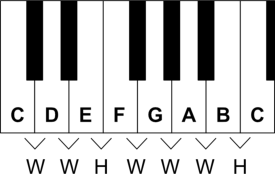
home \ courses \ music theory \ page 2
The major scale
In the scale we just played - the major scale - the distance between the different notes is a whole tone or a demi(half)tone. If this is new to you, it may seem a bit strange. There are more things in music theory that do not always seem logical at first glance. Don't worry, as you learn more you will see the logic behind it more and more. The smallest possible distance between two notes is a semitone. The division in the series c d e f g a b c is as follows (H = half/semi tone, W = whole tone):

So that is:"whole whole half, whole whole whole half"
There is a whole tone between C and D.
There is a whole tone between D and E.
There is a semitone between E and F.
There is a whole tone between F and G.
There is a whole tone between G and A.
There is a whole tone between A and B.
There is a semitone between B and C.
You could also say that there are two semitones between C and D. Two between D and E, one between E and F, etc.
On the guitar you can clearly see that there is only a semitone between E and F and between B and C: one fret is a semitone on the guitar. Two frets is a whole tone.
If we would play this major scale of C on a single string, you can clearly see the distances:

On a piano you can see it even better: there is no black key between E and F and not between B and C. The black keys are the notes that are between the root notes (the white keys).

So there are “extra” notes between C and D, between D and E, between F and G, between G and A, and between A and B.
This is where the earlier mentioned flats (b) and sharps (#) come in.
The note between C and D can be seen as a C raised by a semitone, or as a D lowered by a semitone.
If we raise a note by a semitone, we indicate this with a sharp (#).
For example, the note between C and D is called C# (C sharp).
If we lower a note by a semitone, we indicate this with a flat (b). For example, the note between C and D is also called Db (D flat).
So the note between C and D has two names: C sharp (C#) and D flat (Db).
C# and Db sound exactly the same. In music theory, you say that they are “enharmonically” the same.
But why two names for the same note? We will come to that later, when we talk about scales and keys.
<<< Previous page | Next page >>>

Everything on guitartutorials.nl is completely free to access. If you’d like to support my work and help keep this resource growing, any and all donations are deeply appreciated. Thank you, and happy playing!